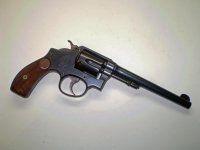jkingrph
Member
I just won an auction for a S&W 1905 hand ejector in 32-20. Not knowing a lot about those old revolvers I have a few questions. First serial number is 109xxx and the gun has a factory letter saying it was shipped in Nov of 1922
1. Is it safe to shoot modern high speed 32-20 factory loads, or should I reload to lower levels.
2. It looks a lot like my much newer K frames, esp the K-22 and K-38, is it a K frame or simply an earlier model?
3. What does hand ejector refer to? I think it simply means opening the cylinder and pressing the ejector rod to eject cartridges.
4. I see 4 screws showing on the sideplate, is this a 4 screw model or a 5 screw, with one hidden under the grip plate?
I sought out this gun to be a companion to a little Marlin 1894 CL in the same caliber, that I bought new back in 2006.
1. Is it safe to shoot modern high speed 32-20 factory loads, or should I reload to lower levels.
2. It looks a lot like my much newer K frames, esp the K-22 and K-38, is it a K frame or simply an earlier model?
3. What does hand ejector refer to? I think it simply means opening the cylinder and pressing the ejector rod to eject cartridges.
4. I see 4 screws showing on the sideplate, is this a 4 screw model or a 5 screw, with one hidden under the grip plate?
I sought out this gun to be a companion to a little Marlin 1894 CL in the same caliber, that I bought new back in 2006.


